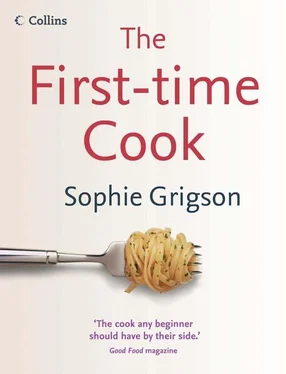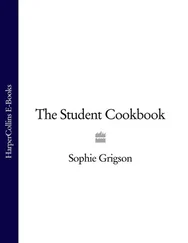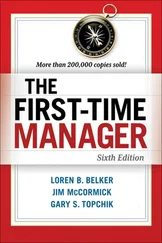Frying Pan, Non-stickAnother investment item. A really tip-top heavy-based non-stick frying pan does not come cheap, but is worth every penny. Choose one that is fairly large with high sides so that as well as frying, you can also cook a chicken stew and the like in it. Incidentally, modern non-stick surfaces are very tough, so it is usually all right to use metal implements in them.
GratersDon’t get too fancy. An old-fashioned box grater does the job very nicely. I like the modern Microplane graters, too, especially for orange and lemon zest, or Parmesan, or nutmeg.
Kitchen TongsThese do make turning practically anything in a frying pan or under the grill ten times easier and quicker.
KnivesBuy the best you can afford (or ask some nice relative with more money than you to make a gift of them). A good knife will last you a lifetime. They’re not cheap, but since you will be using them constantly, knives should be seen as a major investment. You will need, at the very least, one fairly big chef’s knife (around 17.5–20cm/7–8in), one smaller 15cm (6in) knife and a bread knife. A smaller serrated knife (around 10cm/4in) is great for cutting tomatoes.
Knife SharpenerAs essential as the knives. A small hand-held knife sharpener is easier.
LiquidiserIf I had to choose, I’d say that a liquidiser is more essential than a processor and a darn sight cheaper, too. Liquidisers are important for making soup and smoothies amongst other things. For more on liquidisers, turn to page 17.
Pestle and MortarTwo most important characteristics: firstly, that the mortar needs to be heavy, so that it doesn’t slip and slide around on the table. Secondly, the interior must feel rough. If it is smooth it will make grinding and pounding hard work. Best pestles are rough at the wider end, rather than smooth.
SaucepansYou’ll need one small one, one medium-sized one and one large. And no doubt you will add more over the years. When choosing your saucepans, look for solid, heavy bases that will conduct heat evenly.
SieveI prefer metal, but modern nylon sieves are fine. More important than the material is the mesh size. This should be fairly large. If the mesh is too fine, then it can makes things like sieving a soup a complete nightmare. Never buy a sieve which doesn’t have one or two hooks on the rim opposite the handle, so that you can sit the sieve securely over a bowl or saucepan.
Weighing ScalesDigital scales are far more accurate than most dial scales. Buy scales with a flat top, so that you can use any bowl or pan on them, resetting the display to zero before weighing out ingredients.
Baking and Roastingboth refer to cooking in the oven, and the differences between them are not always clear. Generally, however, roasting is done at a high temperature without covering the food, so that it browns, while baking is undertaken at a slightly lower temperature and the food may sometimes be covered or not.
Fryingmeans to cook something in hot fat, either in a shallow frying pan (sometimes also called pan-frying), or in a deep pan, half filled with oil, which is known as deep-frying.
Grillingmeans to cook food under a hot grill.
Sautéingis a form of frying. Unlike ordinary frying, which is verging on sedate, sautéing is an energetic business. The word ‘sauter’ is literally the French for ‘to jump’ and that describes the method well. When sautéing the idea is to keep all the pieces of food moving more or less constantly, so that they brown and cook evenly on all sides, and never have a chance to stick on the base of the pan.
Searing and GriddlingSearing means cooking food with the minimal amount of fat, on a searingly hot flat surface – probably a heavy-based frying pan. Griddling is similar, but a ridged, heavy griddle pan is used instead.
Simmeringmeans cooking something in simmering water, in other words water that is so hot that a few small bubbles are lazily making their way up to the surface, but not much more than that. The surface of the water will move and tremble gently. In most instances water is first brought up to the boil (i.e. when crowds of bubbles rise ebulliently to the surface), the item that is to be cooked is tipped in, which reduces the temperature of the water below simmering point, and then the whole lot is warmed up again until the water is simmering.
Sweatingmeans cooking over a low heat, with a small amount of fat, the lid clamped on tightly.
Chapter one Soups, Starters and Eggs
Soups
I’m a great believer in soup. Here is a dish that fulfils a multitude of functions, the prime amongst them being that it satisfies the soul. Oh – and the stomach. A big steaming bowlful of soup can really hit the spot. It makes a good first course and it makes the heart of a handsome lunch or supper, eked out with loads of soft-centred, crisp-crusted bread, a big hunk of cheese, and healthy fruit or something more indulgent to follow. Make one big batch and it will feed a crowd, or just feed you on your own quickly and easily over several days.
Soups divide, fundamentally, into three categories. The first is the puréed soup, with vegetables aplenty boiled up together, then liquidised to silky smoothness (or if you prefer, rustic chunkiness). The second is the bits and bobs, meal-in-a-bowl soup, where a pleasing medley of this and that is simmered in broth, which may or may not be thickened. The third is the incredibly elegant upmarket consommé – a beautiful limpid concoction, intensely flavoured, served in suitably small quantity with maybe a single oyster or whatever floating in its centre. This is restaurant soup, not impossible to make at home by any means, but a good deal of work. If you want a recipe for this type of soup, look elsewhere.
Making soup is all about extracting the maximum flavour from a set of ingredients. Certain techniques, like sweating vegetables and thickening or thinning the soup, are essential to a good result, while others, like stock-making, can be circumnavigated but are worth learning because they have the potential to turn a pedestrian but acceptable soup into a first-rate one. If you want to get the best soup on to your table, read these tips and techniques before you get out the saucepan.
First, a word about the basic structure of a soup. Most soups start off with a group of base ingredients (e.g. onion, garlic, butter or olive oil) that give the soup a background flavour. The main ingredients are what give the soup its predominant flavour – carrots, perhaps, or parsnips, or a medley of vegetables and beans.
Aromatics are the complementary ingredients that scent or spice the soup – usually herbs and spices. The commonest of these is a ‘bouquet garni’ which is a bundle of different herbs, tied together with string so that it can be easily removed before liquidising or serving the soup (see page 20).
All soups need some sort of liquid otherwise they wouldn’t be soups at all! And then last, but not at all least, they need to be seasoned with salt and pepper, or maybe cayenne pepper for a dash of colour and heat combined.
Sweating without Perspiration
Most puréed soups and many meal-in-a-bowl soups start off with a spot of sweating. Not the sort that requires a cold shower, but sweating of the culinary sort. Foodie sweating means cooking vegetables and often herbs with a little fat, over a very low heat, with the lid clamped firmly on the saucepan. Once they are on the stove-top, you barely need to bother with them for a good 10–15 minutes, apart from giving them a quick stir once or twice, but no more. This process develops the full depth of flavour of the vegetables so don’t try to rush it. As long as the heat is low, they’ll produce enough liquid to prevent them sticking or burning.
Читать дальше












